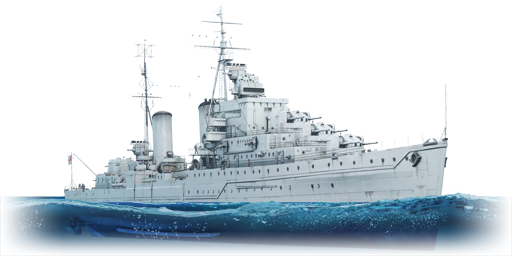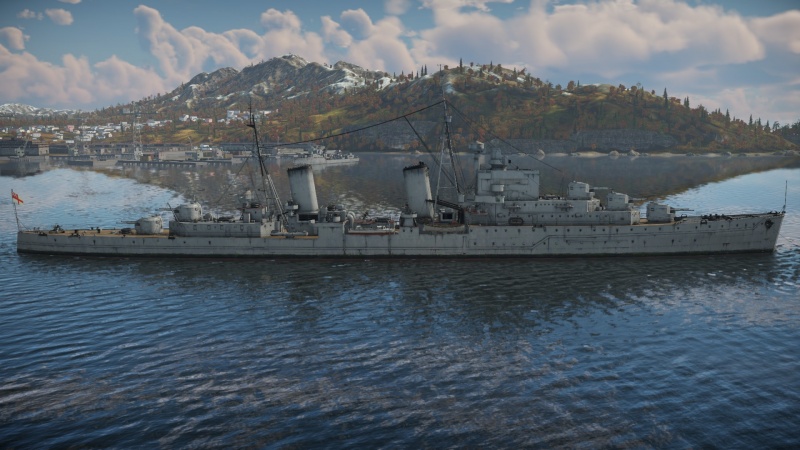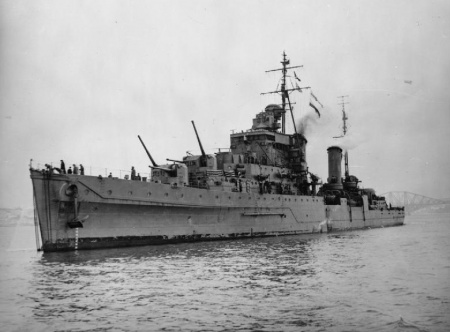HMS Dido
Contents
Description
The Dido-class, HMS Dido (37), 1941 is a rank IV British light cruiser with a battle rating of 5.3 (AB/RB/SB). It was introduced in Update 1.85 "Supersonic".
General info
Survivability and armour
As with all British cruisers, the armour is intelligently dispersed between ammunition storage, boiler rooms, and other essential components. The ammunition storage on the Dido is well below the waterline and is protected by 76 mm of RHA. The only noticeable weaknesses are the unprotected bridge and meagre turret armour.
Mobility
Write about the ship's mobility. Evaluate its power and manoeuvrability, rudder rerouting speed, stopping speed at full tilt, with its maximum forward and reverse speed.
| Mobility Characteristics | |||
|---|---|---|---|
| Game Mode | Upgrade Status | Maximum Speed (km/h) | |
| Forward | Reverse | ||
| AB | |||
| Upgraded | 70 | 30 | |
| RB/SB | |||
| Upgraded | 60 | 26 | |
Modifications and economy
Armament
Primary armament
The accuracy of the 5.25-inch guns is extremely poor. Against aerial targets, the AA AI armed with HE-VT can bring down a target through sheer volume of fire. Against other light cruisers and even destroyers at normal engagement ranges, the Dido suffers.
Secondary armament
Some ships are fitted with weapons of various calibres. Secondary armaments are defined as weapons chosen with the control Select secondary weapon. Evaluate the secondary armaments and give advice on how to use them. Describe the ammunition available for the secondary armament. Provide recommendations on how to use them and which ammunition to choose. Remember that any anti-air armament, even heavy calibre weapons, belong in the next section. If there is no secondary armament, remove this section.
Anti-aircraft armament
The anti-aircraft armament of the Dido is excellent. The dual-purpose primary armaments, 8 x 40 mm guns, and 5 Oerlikons mean that a Dido player can counter planes at all ranges.
Additional armament
6 torpedoes, 3 per side. The firing arcs are wide, allowing for ease of fire.
Usage in battles
The Dido boasts good armour and protected ammunition in exchange for aimed fire worse than many 4.3 destroyers. Whether or not this extreme tradeoff is worth it will come down to the individual player. It is not advised to engage other CLs with the Dido. Against DDs, the Dido can take considerably more damage and will usually win.
Pros and cons
Pros:
- Good survivability
- Good anti-aircraft potential
- Primary armament dispersed across 6 turrets
Cons:
- Slow turret rotation
History
HMS Dido (37) was a British AA cruiser and the lead ship of her class, a series of 16 ships built in the late 1930s to the early 1940s. Designed for fleet air defence, the ships were armed with a 5.25-inch (133 mm) main battery capable of engaging both ships and naval vessels. Dido was commissioned in 1940 and deployed to the Mediteranean, serving there for the large part of the Second World War. She later deployed to the Arctic, and in 1945 accepted the surrender of the Kriegsmarine. Dido was present at the Coronation review of 1953 as the flagship of the Reserve fleet, and was scrapped in 1957.
Design and development
Following the four ships of the Arethusa class, the British navy decided to construct a new class of light cruiser for anti-aircraft duties - the Dido class. Displacing 6850 tons on full load, the ships were small even for a light cruiser. Their armour was also scarce, the main belt being just 3 inches (76 mm) thick. The Dido’s main armament comprised 10 5.25-inch (133 mm) guns in five dual-purpose turrets, which served as the primary anti-ship and anti-aircraft armament. Her anti-aircraft armament was initially weak (quite surprising given her role), composed of three quad pom-poms and five single Oerlikon cannons; this was improved over the course of the Second World War. Dido was initially laid down in 1937, and was commissioned by 1940.
Operational history
Immediately after her commissioning, the Dido was sent to Scapa Flow, and spent the next couple months in training. However, she was soon dispatched to the British fleet in the Mediterranean, and soon began operating as part of the British East Mediterranean fleet. She ran supplies to Malta, and later helped move 7 million dollars of Gold away from the conflict-torn lands of Greece. She participated in several runs to the besieged island of Crete and was later damaged by bombs while escorting a troop convoy to Alexandria. She was later bombed again, but quickly repaired as she made up a significant portion of the ship-starved British East Mediterranean fleet.
Dido spent the greater part of 1942 and 1943 in the Mediterranean, though she travelled back to the UK on several occasions for various reasons. In 1944, she was recalled to the UK and began convoy operations in the Arctic, and thereafter stayed in the northern Atlantic to lay mines and provide fire support. In May of 1945, she fired the last naval shot in Europe as she accepted the surrender of the Kriegsmarine; she then escorted the cruisers Prinz Eugen and Nurnberg to internment at Wilhelmshaven. Following the cessation of hostilities, Dido was reduced to reserve; she took part in the 1953 Coronation review of Queen Elizabeth II as the flagship of the reserve fleet. She was eventually sold for scrap in 1957.
Devblog
The Dido-class light cruiser was designed in the 1930s as convoy escorts and destroyer leaders, intended for operations in the Mediterranean. As such, ships of the Dido-class had to be both large enough to operate in rough waters as well as fast and manoeuvrable enough in order to keep up with destroyers, whilst at the same time remaining relatively cheap to produce in large numbers.
HMS Dido, the lead ship of her class, was laid down in October 1937. In July 1939, Dido was completed and commissioned into service a year later. HMS Dido's early service life was marked with convoy escort duties in the Atlantic, before joining the Eastern Mediterranean Fleet in April 1941.
As part of the Royal Navy's Mediterranean forces, HMS Dido took part in numerous major operations, including the landings at Sicily and mainland Italy as well as southern France. During her service in the Mediterranean, HMS Dido performed various roles, from doing supply runs over evacuating troops to bombarding shorelines.
By 1944, HMS Dido briefly returned to Great Britain, before being sent off on escort duties as part of the Arctic convoys. In 1945, HMS Dido was sent to Copenhagen, where the warship fired the last naval shot as part of the war in Europe, however not in anger, but in celebration of the surrender of the German Kriegsmarine.
Sometime after the end of WW2, HMS Dido joined the ranks of the Royal Navy reserve fleet, remaining in service for another good decade. In 1957 however, HMS Dido was decommissioned from service and sold for scrap.
Media
Excellent additions to the article would be video guides, screenshots from the game, and photos.
See also
Links to articles on the War Thunder Wiki that you think will be useful for the reader, for example:
- reference to the series of the ship;
- links to approximate analogues of other nations and research trees.
External links
References
- Mason, G. B., & Smith, G. (2004). HMS Dido, British AA Cruiser. Retrieved January 07, 2021, from https://www.naval-history.net/xGM-Chrono-06CL-Dido.htm
- Helgason, G. (1995). Uboat.net. Retrieved January 07, 2021, from https://uboat.net/allies/warships/ship/4010.html
| Britain light cruisers | |
|---|---|
| Emerald-class | HMS Enterprise |
| Dido-class | HMS Dido |
| Leander-class | HMNZS Leander |
| Arethusa-class | HMS Arethusa |
| Town-class | HMS Belfast · HMS Liverpool · HMS Southampton |
| Tiger-class | HMS Tiger |
| Abdiel-class* | HMS Abdiel |






